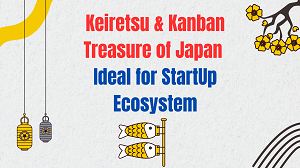02052023 Editorials, JAPANESE STRATEGY:
- How can we reduce the mortality in STARTUPs
- What are Japan’s lessons for the ecosystem
- What is a KANBAN BOARD
- What is meant by the concept of KEIRETSU
- What are the long-term strategies to keep growing
History speaks volumes of resilience from Japan, also known as NIPPON. The aftermath of the atomic bombing on Hiroshima and Nagasaki in August 1945 should have been a major setback for this current most developed nation.
However, what made Japan bounce back and remain on top ever since then? Discipline, Dedication and Determination to pull the shattered strings together in creating a robust economy which even the major countries would envy, is the strength of this island country in East Asia.
Let’s analyze the secrets of this country that could help our STARTUP ecosystem thrive better. “According to a study, up to 90% of STARTUPS fail. Across almost all industries, the average failure rate for year one is 10% However, in years two through five, a staggering 70% of new businesses will fail.”
Our team believe that the two major strategies, apart from the political perseverance of leaders proved successful and could be the ‘must follow’ principles for the Indian STARTUP ecosystem scale taller peaks. They are the KANBAN Board and the concept of KEIRETSU.
‘Japan’s business strategy is unique in many ways, with a focus on quality, innovation and long-term relationships. This approach has allowed Japanese companies to achieve remarkable success in all industries.
One of the tools the KANBAN Board designed by the Toyota Production System in the 40s is a sure shot to success when followed with austerity. KANBAN Board is a ‘project management tool used to visualize and track work in progress. KANBAN Board consists of columns representing different stages of the workflow, with cards or sticky notes representing individual tasks or work items. The system was designed to improve efficiency and reduce waste in manufacturing processes. The KANBAN Board typically consists of three main columns:
To-Do Work / Tasks: This column represents work that has not yet been started. It may include tasks that have been identified but not yet prioritized, or tasks that are waiting for resources or dependencies to be resolved.
Work In Progress: This column represents work that is currently being worked on. It may include tasks that have been started but are not yet complete.
Work Done: This column represents work that has been completed. It may include tasks that have been fully completed, as well as tasks that have been partially completed but are no longer being actively worked on.
Additional columns can be added to the board as needed, depending on the complexity of the project or the specific needs of the team. For example, a column for testing or quality assurance might be added to the workflow.
The KANBAN Board is designed to provide a visual representation of the work that needs to be done, as well as the progress that has been made. This allows team members to quickly and easily see what tasks are currently being worked on, what tasks are coming up next, and what tasks have been completed. It also allows for easy identification of bottlenecks or areas where work is getting stuck so that the team can take action to address these issues.
The KANBAN Board is a powerful tool for managing projects and improving workflow efficiency. By providing a clear and visual representation of the work that needs to be done, it helps teams stay organized, prioritize tasks, and identify opportunities for improvement.
Japanese companies place a strong emphasis on long-term relationships with customers, suppliers, and employees. This is exemplified by the concept of KEIRETSU, which refers to a network of companies with interlocking relationships and shareholdings. This network is often based on long-term relationships and mutual trust, allowing companies to work together towards common goals and achieve greater success than they would be able to individually.
Japan’s business strategy is characterized by a focus on quality, innovation, and long-term relationships. This approach has allowed Japanese companies to achieve remarkable success in a range of industries and it continues to be a model for business success around the world. And our STARTUP founders need to adopt such robust systems that create a vibrant workplace, helping success rates reach optimum levels.’
Please like our pages: on Facebook & LinkedIn. #Way2World brings #StartUpNews from #StartUpResources about #StartUpFounders, #Co-Founders, #WomenEntrepreneurs, #WomenLeaders, #StartUpMentors, #StartUpInnovation #StartUpIncubators, #StartUpAccelerators and #StartUpListing. The #StartUpArticles, #StartUpReviews and #StartUpStories discuss #StartUpFunding, #IndianStart-Ups their #BusinessServices along with #StartUpName and #technologyimpactness. With Inputs from the Internet – RajKishan
DISCLAIMER: The above news item is provided for informational purposes only and does not constitute professional advice, legal opinion, or endorsement by WAY2WORLD. The accuracy, completeness, or timeliness of the information contained in this news item cannot be guaranteed. WAY2WORLD or its affiliates shall not be held liable for any errors, omissions, or damages arising from the use of the information provided. Readers are advised to verify the information from multiple sources and seek professional advice before making decisions based on the content of this news item. The views and opinions expressed in this news item are those of the author(s) and do not necessarily reflect the views of the publisher or its affiliates. WAY2WORLD does not endorse or promote any specific product, service, or organization mentioned in this news item unless otherwise stated. Readers are encouraged to use their discretion and judgment when interpreting and applying the information provided in this news item.

